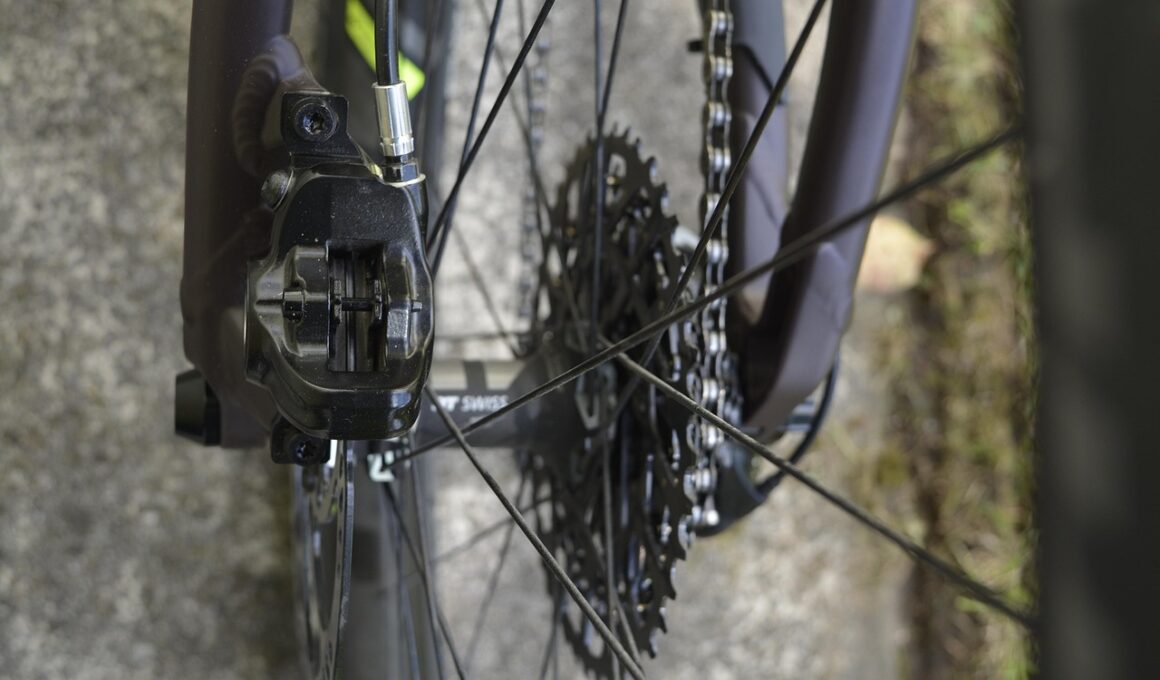The Importance of Brake Fluid Replacement for Hydraulic Bikes
Hydraulic brake systems on bikes are key to ensuring safety on various terrains. One often overlooked aspect of maintenance is the replacement of brake fluid. Brake fluid is essential in hydraulic systems, transmitting force from the lever to the pads. Over time, this fluid can absorb moisture, becoming less effective. This process leads to a decrease in the braking power and compromise safety. The dangers of riding with degraded brake fluid can be severe, including longer stopping distances and a potentially complete brake failure. It’s recommended that cyclists check and replace brake fluid regularly, ideally every 1 to 2 years depending on riding frequency and conditions. Factors like humidity and temperature can accelerate fluid degradation. Hence, being proactive with maintenance is crucial. Understanding the importance of proper brake fluid quality is paramount. Regular inspections can help identify any leaks or contamination, ensuring optimal performance. For those unsure about the process, consulting with a professional bike mechanic is an excellent option. This simple step can greatly improve safety and functionality. By investing time in brake fluid replacement, cyclists protect themselves and enhance the overall experience on their bike.
Another significant aspect of brake fluid management is understanding the types of brake fluids available. Most bicycles using hydraulic brakes utilize either mineral oil or DOT fluid. These two types are not interchangeable, which can lead to complications during maintenance. Mineral oil is usually found in systems made by companies such as Shimano, while DOT fluids are used extensively in models from other manufacturers. DOT fluid is hygroscopic, meaning it readily absorbs moisture from air, making regular changes essential. In contrast, mineral oil does not absorb moisture but may still degrade over time due to factors such as contamination. Identifying the correct type of fluid for your system is critical. Using the wrong fluid can damage seals and other components of the braking system, leading to costly repairs. Always consult the manufacturer’s guidelines to ensure compatibility. Keeping the brake system clean should be a priority, as debris can hinder performance. Checking for wear on brake pads and ensuring they are free of contaminants will help maintain overall braking efficiency. By mixing proper fluid management with regular inspections, cyclists can enjoy a safer and more reliable braking experience on their rides.
Safety and Performance Enhancements
Regularly maintaining brake fluid also significantly enhances riding safety and performance. When brake fluid is fresh and clean, hydraulic systems work optimally, providing the best stopping power. The speed at which force is transmitted can literally mean the difference between a safe stop and crashing. With well-maintained brakes, riders can tackle steep descents and technical climbs, knowing they have reliable stopping power. Failure to check brake fluid can lead to soft or spongy brakes, where the lever feels unresponsive. Maintaining the right fluid level is also crucial: too low can lead to air bubbles in the system. Air in hydraulic lines can create an inconsistent feel, which impacts rider confidence. Furthermore, in extreme conditions, such as muddy trails or wet roads, reliable brakes become even more critical. By taking the time for regular checks and replacement, riders are investing in both safety and performance enhancements. Upgrading to high-quality fluids can also make a tangible difference. For anyone serious about biking, ensuring optimal braking performance should never be neglected. Each ride should be enjoyable, knowing that the brakes will work when it truly matters.
Another important component of brake maintenance includes understanding the signs that indicate fluid replacement is necessary. Cyclists should be familiar with their bike’s braking performance to identify when problems arise. Some signs include reduced braking efficiency, strange noises, or an unusual feel at the lever. Inconsistent brake response or a noticeable increase in braking distance suggests that it may be time for a fluid change. Regular visual inspections can help identify discoloration in the fluid, indicating contamination. If your hydraulic brake system contains bubbles, this is a clear indicator of air needing to be purged from the lines. Listening for grinding noises when braking may suggest that the pads are worn down or that the brake fluid is past its lifespan. Another good practice is to note how often the bike is used and the conditions it faces, such as rain or mud, which can contribute to faster fluid degradation. Identifying these signs early allows for timely discussions with mechanics and avoids accidents effectively. Catching issues early helps maintain optimal performance and prevents costly repairs down the line, allowing for longer bike life and safer rides.
Process of Replacing Brake Fluid
Replacing hydraulic brake fluid isn’t overly complicated, but it does require some knowledge and the right tools. If unsure about the process, consulting with a professional is always a safe option. It typically begins with selecting the proper fluid type specific to your biking system, as mentioned previously. Gather the necessary tools, which may include a bleed kit, a collection bottle, and a wrench. Start the process by removing the wheel to access the brake caliper easily. Attached to the caliper are bleed screws; these need loosening to allow the old fluid to escape. It’s vital to make sure that the new fluid can flow smoothly while eliminating any air trapped in the system. After draining the old fluid, fill the reservoir with fresh fluid, ensuring to avoid overfilling. Carefully pump the brake lever to remove air bubbles and check for consistent tension. Once complete, tighten the bleed screws and reinstall the wheel. Cleaning any spilled fluid immediately prevents unintentional damage to the bike frame or components. Following these steps enables a straightforward and effective way to maintain optimal brake function.
In addition to proper replacement techniques, ensuring that the bike is adequately cleaned after a fluid change is essential for ongoing maintenance. Brake fluid can be corrosive, especially if any spillage occurs on different parts of the bike. After replacing the fluid, use a clean, water-dampened cloth to wipe off any mess. Proper attention to the surrounding areas prevents unintended rust and damage on the bike. It’s also recommended to perform a test ride after completing the fluid replacement. This ride will help verify that the brakes engage appropriately and without any signs of noise or sponginess. Pay attention to firmness at the lever and the responsiveness of the brakes while riding. If anything feels off, revisit the process to ensure everything is correctly done. Regular testing and visual inspections after maintenance can help you identify problems before they become serious, ensuring long-term safety on your rides. Cyclists should consider documenting each maintenance session, storing them in a log, to track performance over time. Small maintenance habits can prevent larger issues down the road and maintain the longevity of the braking system.
Conclusion: Emphasizing Brake Fluid Maintenance
In summary, the importance of regular brake fluid replacement for hydraulic bikes cannot be overstated. Safety, performance enhancement, and avoiding costly repairs all hinge on how well cyclists maintain their braking systems. Checking type compatibility and recognizing signs of fluid degradation allows riders to be proactive instead of reactive. Entrusting brake fluid management to professionals can protect against mishaps and prolong the bike’s functional lifespan. By incorporating good maintenance practices, such as regular inspections and thorough cleaning, cyclists stand to gain greater confidence during rides. Investing a few moments into brake fluid management ultimately leads to improved performance and a safer riding experience overall. The psychological benefits of knowing that one’s brakes are reliable cannot be underestimated. Cyclists who adopt proper maintenance routines find that their overall experiences are more enjoyable, reducing stress and enhancing pleasure during rides. The key takeaway is to treat brake fluid replacement not as a chore but as an essential part of cycling that safeguards your adventures. Ultimately, the relationship between a cyclist and their brake system represents a partnership based on trust and diligence, ensuring every ride is both exhilarating and safe.
In conclusion, treating brake fluid replacement as an integral part of your cycling routine ensures safety and performance and enhances the overall riding experience. Whether commuting or undertaking more intensive mountain biking sessions, knowing that the brakes are in peak condition allows for smoother rides. Maintenance habits developed over time lead to greater mechanical understanding of your bike. As with most mechanical systems, prevention is always more effective than a cure when it comes to hydraulic brake systems. So next ride, take a moment to reflect on your braking mechanism. Regularly replacing brake fluid is a simple but crucial task that can have profound implications for both safety and performance. For cyclists sincerely passionate about riding, every detail matters. A bike is more than just a mode of transport; it’s a ticket to adventures and exploration, making it incredibly important to ensure frequent maintenance. Seeking help from professionals can ease the burden and ensure efficient management while learning from the process. By developing these habits, cyclists can enjoy a successful riding journey filled with exciting experiences and reliable brakes.


